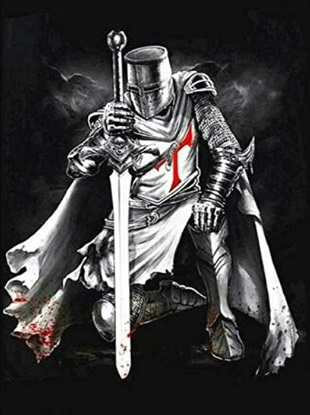The Knights Templar, Rumble Bumble
Paul Smith
7 May 2023
Modified 22 June 2024
Pierre Plantard discarded the Priory of Sion connection with the Knights Templar after 1989 in his second revised pedigree of his Priory of Sion.
Quoting from the article “Some Archives of the ‘Priory of Sion’ discovered in Barcelona...” by Ursanne (that also contains a different Grand Masters List), Vaincre Number 3, September 1989, page 22:
“We are now able to officially state that the PRIORY OF SION has no direct or indirect connection with the ORDER OF THE TEMPLE, and that all this fantastic succession of Grand-Masters that authors such as Philippe TOSCAN, Mathieu PAOLI, Henry LINCOLN, Michael BAIGENT, Richard LEIGH, etc. have attributed to it derive merely from people’s imaginations and the realm of fantasy”.
So there is no more necessity to discuss the Knights Templar. Here is a condensed review covering the earliest Templar myths written over one year ago.
ORIGINS OF THE MYTH OF THE TEMPLARS
It seems that the first person to be formally tried for practicing ritual magic was Pope Boniface VIII, and he was tried posthumously. This happened in 1310-1311, in the aftermath of the pope's struggle with Philip the Fair of France, and it was the work of Philip the Fair's devoted servant, Guillaume de Nogaret, before he turned similar accusations against the Knights Templar.
The point is this: the accusations that were levelled against the Knights Templar fitted-in with what was happening politically in Europe and the behaviour of Philip the Fair, King of France.
The earliest known person to link the Knights Templar with occultism was Heinrich Cornelius Agrippa, who decided to place the Knights Templar alongside the witches (in his three volume book, De Occulta Philosophia, 1531-1533).
When Freemasonry became established in France, it created initiation degrees into the Order of the Knights Templar, that gave birth to the monster of Mystic Templarism. It was literally anything goes from this point on and soon the Knights Templar were established as the secret archaeologists of the Temple of Solomon.
One of the earliest creators of the Templar Myth was “George Frederick Johnson” (pseudonym of a Frenchman who died in 1775). He claimed the Knights Templar discovered treasures at the Temple Mount that had once belonged to the Essenes and that they emigrated to Scotland. He was “Knight of The Great Lion of The High Order of The Lords of The Temple at Jerusalem” and “Provost-General of The Templar Order of Scottish Lords”. He did not claim that the Knights Templar discovered the Ark of the Covenant. That privilege belonged to Louis Charpentier in his book, Les Mystères de la Cathédrale de Chartres (1966).
The 18th century witnessed Knights Templar illuminees like Johann August von Starck and Karl Gotthelf von Hund, hoping to create an Empire of Freemasonic Adepts and Masters that was nothing more than a figment of their imagination.
Multitudes of myths have arisen about the Knights Templar ever since and none of them are worth the paper they are written on.
Quoting Helen Nicholson: “The Romance movement of the eighteenth and nineteenth century made much of the Templars as flawed heroes, anti-heroes, or bearers of mysteries, especially as the guardians of the Holy Grail – an image loosely based on just one of the numerous medieval stories about the Holy Grail. These myths about the Templars threaten to make serious scholarship impossible, by discrediting them as a subject of academic research” (The Knights Templar. Past Imperfect; Arc Humanities Press, 2021).

|
